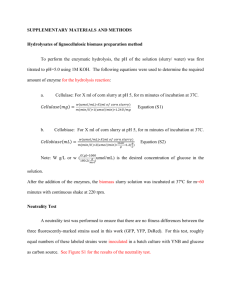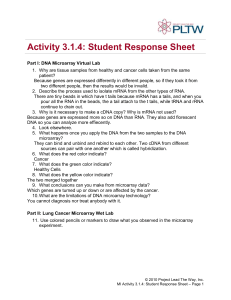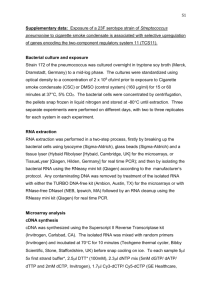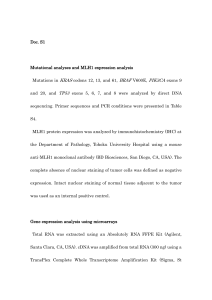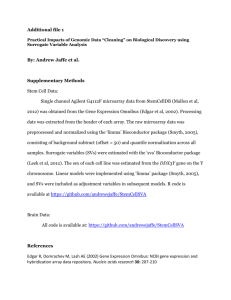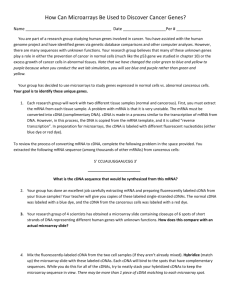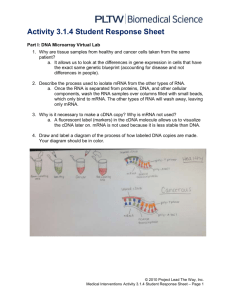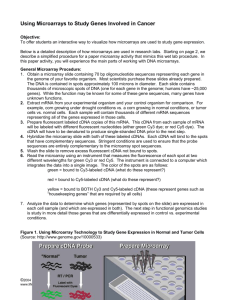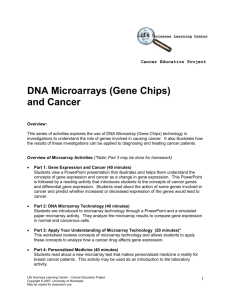Microarray Simulation Student Handout
advertisement
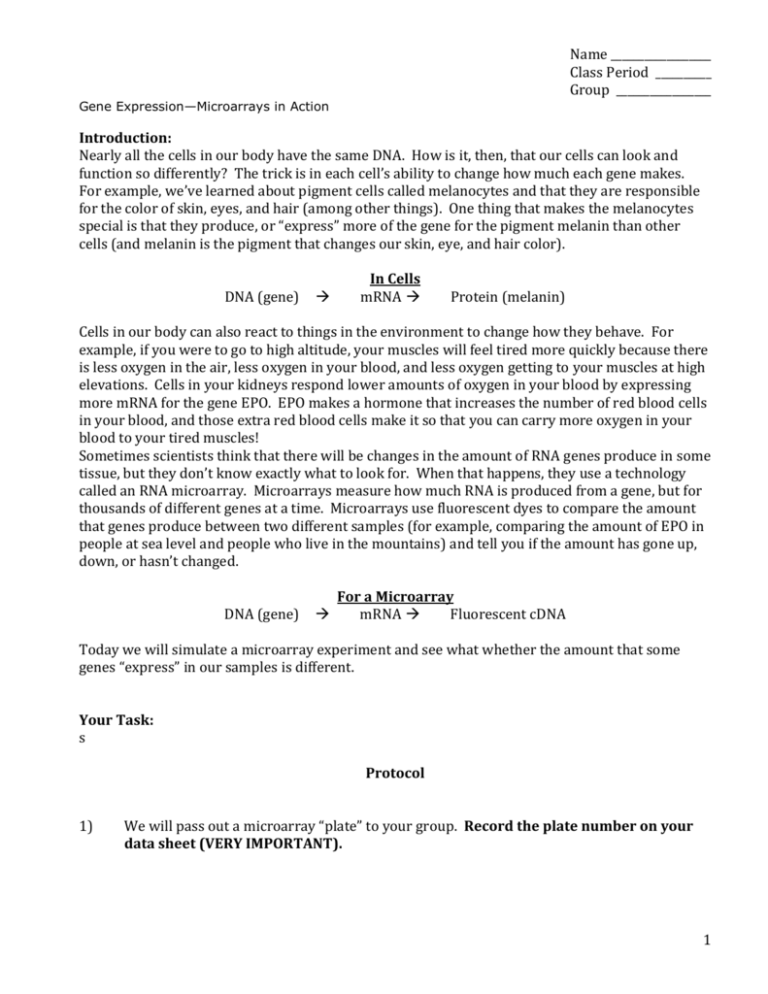
Name __________________ Class Period __________ Group _________________ Gene Expression—Microarrays in Action Introduction: Nearly all the cells in our body have the same DNA. How is it, then, that our cells can look and function so differently? The trick is in each cell’s ability to change how much each gene makes. For example, we’ve learned about pigment cells called melanocytes and that they are responsible for the color of skin, eyes, and hair (among other things). One thing that makes the melanocytes special is that they produce, or “express” more of the gene for the pigment melanin than other cells (and melanin is the pigment that changes our skin, eye, and hair color). DNA (gene) In Cells mRNA Protein (melanin) Cells in our body can also react to things in the environment to change how they behave. For example, if you were to go to high altitude, your muscles will feel tired more quickly because there is less oxygen in the air, less oxygen in your blood, and less oxygen getting to your muscles at high elevations. Cells in your kidneys respond lower amounts of oxygen in your blood by expressing more mRNA for the gene EPO. EPO makes a hormone that increases the number of red blood cells in your blood, and those extra red blood cells make it so that you can carry more oxygen in your blood to your tired muscles! Sometimes scientists think that there will be changes in the amount of RNA genes produce in some tissue, but they don’t know exactly what to look for. When that happens, they use a technology called an RNA microarray. Microarrays measure how much RNA is produced from a gene, but for thousands of different genes at a time. Microarrays use fluorescent dyes to compare the amount that genes produce between two different samples (for example, comparing the amount of EPO in people at sea level and people who live in the mountains) and tell you if the amount has gone up, down, or hasn’t changed. DNA (gene) For a Microarray mRNA Fluorescent cDNA Today we will simulate a microarray experiment and see what whether the amount that some genes “express” in our samples is different. Your Task: s Protocol 1) We will pass out a microarray “plate” to your group. Record the plate number on your data sheet (VERY IMPORTANT). 1 2) Name __________________ Class Period __________ Group _________________ The microarray compares normal tissue and our mystery cDNA, we have already mixed normal cDNA with the mystery cDNA. Go get a sample of cDNA and take it to your table. Record your mystery cDNA Sample ID (A or B) on your data sheet—VERY IMPORTANT. 3) It is important to know which way to “read” your microarray plate. Position your plate so that the A1 square is in the upper left (see the diagram on the data sheet). 3) Add three drops of your mystery cDNA to each well of the microarray plate. Record the color of each well of the plate on your data sheet (use colored pencil or just write the color). 4) Look at your microarray gene key to determine which genes are producing more mRNA (and cDNA) in your mystery samples: More mRNA / cDNA in mystery sample = Pink / Red Less mRNA / cDNA in mystery sample = Green No change = Blue / Purple Data Sheet Microarray Plate ID: _______________________________________ Mystery Sample ID: _______________________________________ 2 Name __________________ Class Period __________ Group _________________ Microarray Plate A 1 GRIN2B 2 NR4A2 3 GAPDH 4 OPRK1 5 BDNF 6 ACTB 7 MIF 8 CREB1 B GABRA1 CARTPT NTRK2 DRD2 MAG EGFR SIRT1 TBP Questions 1) Exercise is known to increase expression of BDNF, CREB1, and GRIN2B while lowering GABRA1, MAG, and MIF. Cocaine use if known to increase expression of BDNF, CARTPT, CREB1, and EGFR1 and decrease DRD2, OPRK1, and NTRK2. Which mystery cDNA sample did you get? _________________________________________________________________________________________________________ 2) Microarrays compare the amount of RNA/cDNA between two different conditions (for example normal and cocaine use). What color changes would you expect to see in our microarray if we compared two similar samples (like two samples from cocaine users)? _________________________________________________________________________________________________________ _________________________________________________________________________________________________________ _________________________________________________________________________________________________________ 3) Choose one of the genes that has changed expression in your microarray. Use the class laptops to look up your gene (using either the NIH’s website: http://www.ncbi.nlm.nih.gov/gene or Genecards: http://www.genecards.org/, some of the 3 Name __________________ Class Period __________ Group _________________ genes even have Wikipedia entries). Write down at least three pieces information about the gene (for example, BDNF is short for “brain-derived neurotrophic factor!”). Name of gene: ________________________________________ _________________________________________________________________________________________________________ _________________________________________________________________________________________________________ _________________________________________________________________________________________________________ _________________________________________________________________________________________________________ _________________________________________________________________________________________________________ _________________________________________________________________________________________________________ _________________________________________________________________________________________________________ _________________________________________________________________________________________________________ _________________________________________________________________________________________________________ _________________________________________________________________________________________________________ _________________________________________________________________________________________________________ _________________________________________________________________________________________________________ _________________________________________________________________________________________________________ _________________________________________________________________________________________________________ _________________________________________________________________________________________________________ _________________________________________________________________________________________________________ _________________________________________________________________________________________________________ _________________________________________________________________________________________________________ 4

